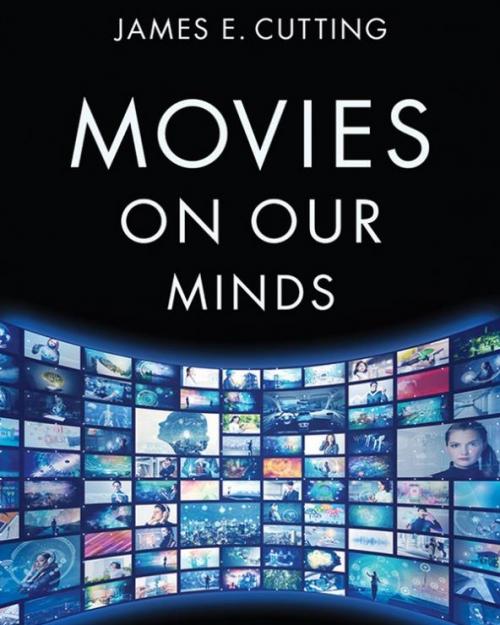A lifelong movie buff, James Cutting remembers cowering in the back seat of his parents’ car during a drive-in summer showing of “The Mountain,” a 1956 Spencer Tracy film about a plane crash in the French Alps.
At some point in the harrowing drama, Cutting surprised his parents by poking his head up to join them in watching intently. A shift to triumphal music, he explained to them, had signaled it was safe to do so.
That’s just one of the many ways movies engage our thoughts and emotions, says Cutting, the Susan Linn Sage Professor of Psychology Emeritus in the College of Arts and Sciences. It’s a subject he spent more than a decade researching and explores in depth in a new book, “Movies on Our Minds: The Evolution of Cinematic Engagement,” published Aug. 24.
The book traces the development of popular cinema from its inception to the present day to explain why people have watched more and more movies over the last century, highlighting changes – from sound and color to aspect ratios and shot durations – that have increased viewers’ attention, understanding and emotional involvement in films. Understanding that evolution provides insights into how our minds work, Cutting argues.
“When I watch a good movie, I’m just sucked in,” he said. “I really wanted to know, why do I get sucked in, and why does everyone else get sucked in?”
Cutting discussed his research with the Chronicle.
Question: So, why do movies draw us in psychologically?
Answer: It’s an art form that has evolved to involve us in as many ways as it can – perceptual, cognitive and emotional. And movies tell stories, which are central to our being. We learn from stories, we’re delighted by stories, we’re horrified by stories. The better movies tell stories, the more they engage us.
Q. You write that “movies have been fit to our minds.” How so?
A. Our minds tend to chunk and group things, into what in my field of psychology we call “events.” We impose beginnings, middles and ends on our experience. Films evolved to do that as well. Early films showed slices of life, what the French call “actualités,” but developed to tell stories with narrative structure and style. Scenes became psychological events organized with shots and cuts and dissolves, fade-outs and fade-ins. Movies also tell us about the visual system. For example, they tend to put faces near the center of the screen, which tends to be brighter and have more motion and fills the largest portion of your visual cortex with information. These techniques influence how we perceive, understand and respond emotionally to movies.
Q. How did you study movie structures and how they’ve changed over time?
A. What I’ve done is empirically analyze a century’s worth of popular films, using sampling, statistical methods to look at how their composition has changed across 30 or 40 different norms of film style. For example, the norms include shot and scene durations, which have gotten shorter. I claim they’ve gotten shorter not because our attention spans have grown shorter – a myth – but because our visual processing has become more sophisticated.
Q. The more engaging a movie is, the better, presumably.
A. There’s a tension between engagement and the quality of the movie. We can be really engaged in a movie – can’t look away – while simultaneously thinking it’s vapid. Good movies tell good stories, which can be complicated or slow. I think we judge whether a movie is good or not by the sustained emotional involvement we have with it. How deeply does it touch us? So I don’t think movies are getting “better,” but I do think they are getting more engaging.
Q. Does a movie or scene come to mind that illustrates a change fostering engagement?
A. There’s a wonderful example in “The Graduate” of a manipulation developed in the 1960s called rack focus. At a pivotal moment, the focus changes from the daughter in the foreground to her mother in the background, whose face had been blurred. Our eyes are designed to look at things that are in focus. So the filmmaker is using what we would naturally do to draw our attention, controlling where and how we look.
Q. You say filmmakers create rhythms in movies that are “not unlike those of the human body.”
A. What I’ve discovered with my students is that increasingly over the last 60 or 70 years, popular movies have developed complex, fractal rhythms that are much like the complex patterns we find in our breathing, heart rates and walking. They didn’t used to, but they do now. And the question is, why is that? Maybe these patterns make us feel more comfortable or more engaged. It’s a puzzle.
Q. Any movies you’re looking forward to seeing or would recommend?
A. I usually say my favorite movie is the last one I saw, because I’m still thinking about it. I’ll watch anything that [director] Christopher Nolan has done, although I don’t like all his films. I’m waiting for the next James Bond film to come out, because I’ve seen all of them. I recently binge watched “The Queen’s Gambit” on Netflix and thought it was terrific.
Read the story in the Cornell Chronicle.





